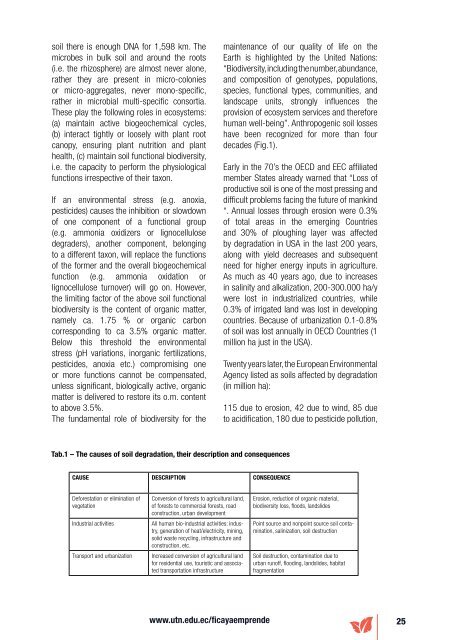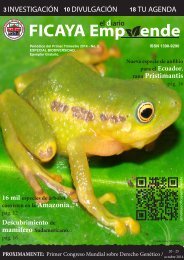Create successful ePaper yourself
Turn your PDF publications into a flip-book with our unique Google optimized e-Paper software.
soil there is enough DNA for 1,598 km. The<br />
microbes in bulk soil and around the roots<br />
(i.e. the rhizosphere) are almost never alone,<br />
rather they are present in micro-colonies<br />
or micro-aggregates, never mono-specific,<br />
rather in microbial multi-specific consortia.<br />
These play the following roles in ecosystems:<br />
(a) maintain active biogeochemical cycles,<br />
(b) interact tightly or loosely with plant root<br />
canopy, ensuring plant nutrition and plant<br />
health, (c) maintain soil functional biodiversity,<br />
i.e. the capacity to perform the physiological<br />
functions irrespective of their taxon.<br />
If an environmental stress (e.g. anoxia,<br />
pesticides) causes the inhibition or slowdown<br />
of one component of a functional group<br />
(e.g. ammonia oxidizers or lignocellulose<br />
degraders), another component, belonging<br />
to a different taxon, will replace the functions<br />
of the former and the overall biogeochemical<br />
function (e.g. ammonia oxidation or<br />
lignocellulose turnover) will go on. However,<br />
the limiting factor of the above soil functional<br />
biodiversity is the content of organic matter,<br />
namely ca. 1.75 % or organic carbon<br />
corresponding to ca 3.5% organic matter.<br />
Below this threshold the environmental<br />
stress (pH variations, inorganic fertilizations,<br />
pesticides, anoxia etc.) compromising one<br />
or more functions cannot be compensated,<br />
unless significant, biologically active, organic<br />
matter is delivered to restore its o.m. content<br />
to above 3.5%.<br />
The fundamental role of biodiversity for the<br />
maintenance of our quality of life on the<br />
Earth is highlighted by the United Nations:<br />
“Biodiversity, including the number, abundance,<br />
and composition of genotypes, populations,<br />
species, functional types, communities, and<br />
landscape units, strongly influences the<br />
provision of ecosystem services and therefore<br />
human well-being”. Anthropogenic soil losses<br />
have been recognized for more than four<br />
decades (Fig.1).<br />
Early in the 70’s the OECD and EEC affiliated<br />
member States already warned that “Loss of<br />
productive soil is one of the most pressing and<br />
difficult problems facing the future of mankind<br />
“. Annual losses through erosion were 0.3%<br />
of total areas in the emerging Countries<br />
and 30% of ploughing layer was affected<br />
by degradation in USA in the last 200 years,<br />
along with yield decreases and subsequent<br />
need for higher energy inputs in agriculture.<br />
As much as 40 years ago, due to increases<br />
in salinity and alkalization, 200-300.000 ha/y<br />
were lost in industrialized countries, while<br />
0.3% of irrigated land was lost in developing<br />
countries. Because of urbanization 0.1-0.8%<br />
of soil was lost annually in OECD Countries (1<br />
million ha just in the USA).<br />
Twenty years later, the European Environmental<br />
Agency listed as soils affected by degradation<br />
(in million ha):<br />
115 due to erosion, 42 due to wind, 85 due<br />
to acidification, 180 due to pesticide pollution,<br />
Tab.1 – The causes of soil degradation, their description and consequences<br />
CAUSE DESCRIPTION CONSEQUENCE<br />
Deforestation or elimination of<br />
vegetation<br />
Industrial activities<br />
Transport and urbanization<br />
Conversion of forests to agricultural land,<br />
of forests to commercial forests, road<br />
construction, urban development<br />
All human bio-industrial activities: industry,<br />
generation of heat/electricity, mining,<br />
solid waste recycling, infrastructure and<br />
construction, etc.<br />
Increased conversion of agricultural land<br />
for residential use, touristic and associated<br />
transportation infrastructure<br />
Erosion, reduction of organic material,<br />
biodiversity loss, floods, landslides<br />
Point source and nonpoint source soil contamination,<br />
salinization, soil destruction<br />
Soil destruction, contamination due to<br />
urban runoff, flooding, landslides, habitat<br />
fragmentation<br />
www.utn.edu.ec/ficayaemprende<br />
25








